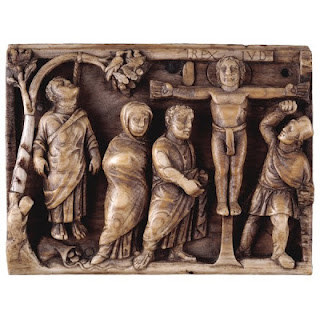Our first image is of the relief of Santa Sabina Basilica in Ravenna, Italy, dated approx. 430 CE.
Note Jesus and the two thieves are standing with their hands nailed to hidden boards. They do not appear to be hanging from a cross, or nailed to a cross. However, they look like three Roman orants in the poses they assume.
Dorothy King, PhD reports that "there were no earlier images of the crucifixion to serves as examples, but Sheckler and Leith in their study of the Santa Sabina doors suggested as a prototype depictions of the Three Boys in the Fiery Furnace (Daniel 3). They give the example from the Catacombs of Priscilla, where several popes were buried, including Celestine who constructed Santa Sabina:"
 |
| Source: Dorothy King's PhDiva. |
 |
| From the Passion Sarcophagus. Source: Dorothy King's PhDiva. |
 |
| Domitian coin. Source: Dorothy King's PhDiva. |
 |
| Ivory plaque ca. 430 CE, One of four surrounding a reliquary, Maxwell Ivories, British Museum, London. |
Dorothy King notes: "It's the earliest depiction of the crucifixion which depicts Jesus for certain, as indicated by the inscription on the titulus crucis: REX IUD[AEORUM]"Note Jesus is nailed to a sort of tau-cross or an ankh-like cross made of fancy boards, with only two nails in the palms, one each. He is depicted hanging stiffly from these nails like a cardboard cutout or a mannekin on a cross made of planks. It is as if the Christian Church relied on the funeral of Julius Caesar (March 17 or 20, 44 BCE), where a wax image of the deified dictator was raised above the bier containing the body. Caesar's wax image was also mounted on a cross or tropaeum, either nailed to it or constructed over it.
 |
| Source: Franceso Carotta, Jesus Was Caesar. |
Indeed, some early Church Fathers in their writings confused the cross (crux, stauros) with the Roman tropaeum in their writings. They are followed by later Fathers who openly declared the cross to be a tropaeum; which, because of its well-known structure we are familiar with, precisely was.
Note Longinus is depicted as stabbing Jesus in his left side. The lancaea that the gospel of John (and in the earliest manuscripts, Matthew also) says he used looks uncannily like a dagger (gladius, pugium, sica, mucro, telum). This does not conform to a stabbing in a Roman executionary suspension scene where the executioners go by certain protocols, but rather, it is similar to one act of stabbing in Julius Caesar's chest by Cassius Longinus, one of 23 stabbings committed during Caesar's assassination by his enemies in the Senate in the porch of Pompey's Theatre, March 15, 44 BCE.
To the left, Judas Iscariot is depicted hanging from a tree exactly as one would expect a man who has hanged himself to hang.
 |
| From the Sarcophagus Domatilla. Called the Passion Sarcophagus by Dorothy King, PhD. |
In this scene, a Roman official (presumably Pontius Pilatus) has arrived for the trial he is to oversee, with an attendant carrying a cross in the same manner as Aeneas is depicted carrying a tropaeum.
 |
| Fresco in Pompeii depicting Aeneas carrying a tropaeum. Source: RavingAthiests.com forum. |
 |
| From the Sarcophagus Domatilla, Anastasis (= Resurrection), ca. 350 CE. Note the tropaeum standing in for the crux. |
Not twenty years after Constantine got rid of the practice in 337 CE, already people were already imagining the Roman crux as a tropaeum. This reflects what three earlier Church Fathers, who compared the two, calling the frame of a tropaeum to be a crux simplex, a schematic of a stauros, and a patibulum (presumably structurally neuter just as the word is grammatically). And I will uncover this in the next post.
 |
| Roman Tropaeum, Charlottenberg Museum, Berlin. Note that what Minucius Felix called a crux simplex is of the crux immissa type. Source: Francesco Carotta, Jesus Was Caesar |

No comments:
Post a Comment